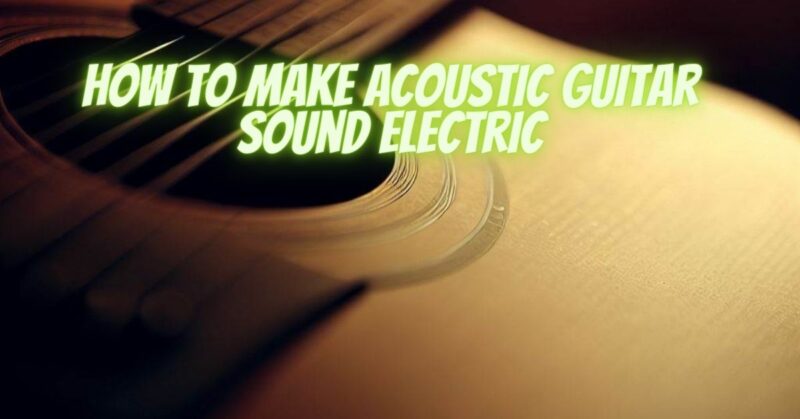The acoustic guitar’s warm and natural sound has charmed music enthusiasts for generations. However, there are times when musicians desire the edgier, versatile tones associated with electric guitars. Enter the realm of transforming the acoustic guitar’s sound into an electric-like tone—a creative pursuit that combines the best of both worlds. Let’s explore the techniques, tools, and considerations that allow you to electrify your acoustic guitar’s sonic palette.
The Quest for an Electric-Like Tone:
Why Transform?
Electrifying your acoustic guitar’s sound opens up a range of tonal possibilities, making your instrument suitable for genres such as rock, blues, and pop. It allows you to experiment with distortion, effects, and sustain while maintaining the essence of the acoustic timbre.
Acoustic-Electric Guitars:
One straightforward approach is to use an acoustic-electric guitar—a hybrid that integrates acoustic and electric elements. These guitars feature built-in pickups and preamps, enabling you to plug into an amplifier or PA system and control your sound.
External Pickup Systems:
For those who want to retain their acoustic guitar’s natural resonance, external pickup systems offer an alternative. These pickups can be attached to the soundhole, bridge, or body, capturing the vibrations of the strings and transforming them into electric signals.
Pedals and Effects:
To achieve an electric-like tone, consider incorporating effects pedals into your setup. Overdrive, distortion, and modulation pedals can shape your acoustic sound to emulate electric guitar characteristics.
Amp Simulators:
Utilizing amp simulators and modelers can simulate the sonic characteristics of various electric guitar amplifiers. These devices process your acoustic guitar’s signal to mimic the tonal nuances of iconic electric amp models.
Considerations for Electrifying Acoustic Sound:
String Choice:
Thicker strings can yield a fuller, more resonant sound when using external pickups. Experiment with string gauges to find the balance between acoustic warmth and electric-like response.
Feedback Management:
Electrifying an acoustic guitar can sometimes lead to feedback issues, especially when using high-gain effects. Proper positioning of pickups, using feedback suppressors, and adjusting your playing technique can help mitigate feedback.
Tonal Expectations:
While you can emulate electric guitar tones on an acoustic, remember that your acoustic’s sound will never be identical to that of an electric guitar. Embrace the unique sonic qualities your acoustic brings to the transformation.
Finding the Right Balance:
Achieving an electric-like tone on an acoustic guitar requires a balance between experimentation and understanding your gear. Don’t be afraid to try different pickup placements, pedal combinations, and amp simulations to find the sonic landscape that resonates with your musical vision.
Preserving Acoustic Identity:
Remember that while you’re aiming to transform your acoustic sound, your guitar’s acoustic identity is its foundation. Embrace the fusion of acoustic and electric elements, creating a distinctive sound that reflects your musical identity.
Electrifying your acoustic guitar’s sound into an electric-like tone opens up a realm of creative exploration. Whether you choose acoustic-electric guitars, external pickups, pedals, or amp simulations, the journey involves discovering new sonic textures while honoring the instrument’s inherent character. The result is a sonic fusion that showcases the versatility of your acoustic guitar while paying homage to the iconic tones of the electric guitar world.


